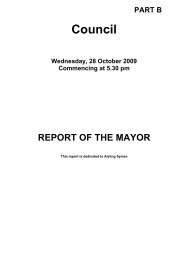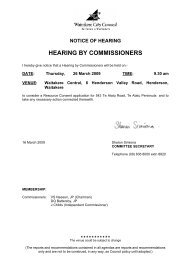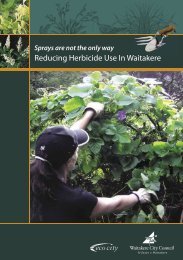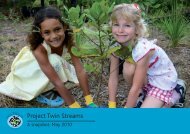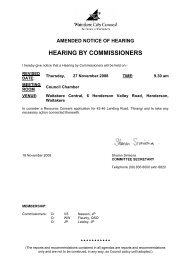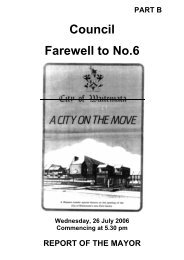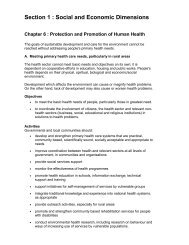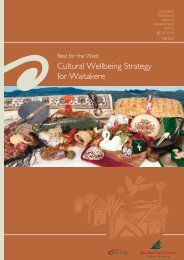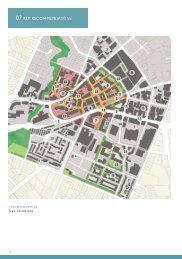Council, 26 April 2007 - Auckland Council
Council, 26 April 2007 - Auckland Council
Council, 26 April 2007 - Auckland Council
Create successful ePaper yourself
Turn your PDF publications into a flip-book with our unique Google optimized e-Paper software.
PART B<br />
<strong>Council</strong><br />
Thursday, <strong>26</strong> <strong>April</strong> <strong>2007</strong><br />
Commencing at 5.30 pm<br />
REPORT OF THE MAYOR
W A I T A K E R E C I T Y C O U N C I L<br />
SUPPLEMENT TO THE AGENDA FOR A MEETING OF THE COUNCIL TO BE HELD AT<br />
WAITAKERE CENTRAL, 6 HENDERSON VALLEY ROAD, HENDERSON, WAITAKERE,<br />
ON THURSDAY, <strong>26</strong> APRIL <strong>2007</strong>, COMMENCING AT 5.30 PM<br />
PART B - REPORT OF THE MAYOR<br />
HOW WE FORM IDENTITY - SOME THOUGHTS<br />
As well as being a good time for chocolate, Easter is a good time to sit back and reflect. Not so<br />
much about religion, well not in my case anyway, but it does make you think about our origins,<br />
our history and our identity. I read several articles on this topic over the break and wanted to<br />
share my thoughts.<br />
Firstly, there was a very interesting article in the New Zealand Herald about the addictive gene.<br />
It said people who don’t have the addictive gene won’t be addicted to anything. Now, I am not a<br />
scientist and would never claim to know the technical ins and outs on this topic; however, I am<br />
certain I have not got the addictive gene. I can try anything once and not get addicted, even if I<br />
ever had inhaled! And I have passed having no addictive gene to my kids. I’ve always thought<br />
this and it was nice to have confirmation that I’ve been right all along.<br />
And then I moved on to an article on the web written by Tom Moore about Additive Identity.<br />
Moore is talking about identity in Brazil but there are many similarities between his thinking and<br />
mine in terms of life in New Zealand. As Moore says, identity can be based on subtraction or<br />
addition - what you might call ‘subtractive’ or ‘additive’ identity. As every parent knows, a child<br />
who uses the word “no” can be very powerful. “No” is a powerful word. Much more powerful<br />
than a simple “yes”. Even when the child is older, and in adulthood, “no” is still a powerful word,<br />
embedded in what you might call an ‘either/or’ way of viewing the world. Either a person is Maori<br />
or Pakeha, heterosexual or homosexual, bad or good, damned or saved, French or Italian. See<br />
what I’m getting at? It’s a dualistic way of operating which can be useful, but it is also simplistic.<br />
Neither does it really reflect reality. People are not simply Maori or Pakeha, because they have<br />
complex heritages which may bring together ancestors from many parts of the world. Some<br />
eminent French were born in Italy.<br />
‘Either/or’ thinking and ‘subtractive’ identity, in which we assert who we are by denying we are<br />
like someone else, seem to have connections with our dominant patriarchal ways of constructing<br />
the world. Becoming a Muslim (or a Christian) means having one belief system and rejecting all<br />
others.<br />
‘Additive’ identity is something we are becoming more familiar with. It’s about creating identity by<br />
taking on new aspects without giving up the old and I think we do that very well in New Zealand.<br />
We are not inhibited about celebrating our mixed heritage. I am sure some people would be<br />
more than happy to say they are the brownest Pakeha or the whitest Maori in town.<br />
And so we have an acceptance of ‘additive’ identity - the practice of ‘both/and’ rather than<br />
‘either/or’. And that feels like a great place to be. In a society based on ‘both/and’ the individual<br />
need not be a nomad, an atom, defined in isolation, but rather a force expressed through a web<br />
of relationships which reinforce each other.<br />
For example, a musician may be a performer and a composer and may work in classical music,<br />
early music, jazz, samba; he or she may be a writer and a poet as well. Identity is not based on<br />
“no, I don’t do that,” “that’s not what I am about” but “yes, I like that, I do that too”. I can be a<br />
councillor and I also can be a printer or an undertaker. This is what I’ve been saying since my<br />
memorable experience with Richard Florida and his fantastic book on how cities and<br />
communities are created and cheered on, The Rise of the Creative Class. Waitakere I think has<br />
this and it’s about recognising and being recognised as an ethnic group with ease, i.e. a Dutchie<br />
or a Dali. And liked and appreciated and respected and part of the community.
Supplement to Agenda -<br />
<strong>Council</strong> 2 <strong>26</strong> <strong>April</strong> <strong>2007</strong><br />
Bryan Mogridge and I often talk about this being the kind of city that has the beginning of real<br />
cultural diversity, not marginalised or ghettoised. We’re closer to the soil. The climate is wilder.<br />
And I sure get cheered up when I see things like this - in 1860 when the Surveyor General and<br />
great painter Charles Heaphy came out west and said: “This country is densely wooded with a<br />
broken surface but very rich soil. From its very hilly character, and from its being in the hands of<br />
the Natives, it has remained, until lately, without attracting attention. Fair lines for roads are,<br />
however, now being found into it, and the district will probably be soon occupied as the site of a<br />
select settlement. It is a rough place, but its soil will grow anything, and it lies within a sturdy<br />
day’s walk of <strong>Auckland</strong>”.<br />
Here in Waitakere we had pioneers but they weren’t just pioneers. They were artists, poets,<br />
winemakers. Yes, we’ve had marginalised people but those people have also been creative and<br />
innovative. And we’ve had a long term real partnership between Maori and Pakeha. Waitakere’s<br />
people are very firmly committed to ‘both/and’ and I think that’s just great.<br />
CRIME IN WAITAKERE<br />
However, all is not rosy in this City that is Waitakere. Our crime statistics have increased<br />
significantly and quite frankly they make horrendous reading. Kidnapping/abduction is up 109<br />
percent, robbery up 57 percent, sexual attacks 45 percent, grievous assaults 32 percent, serious<br />
assaults 11 percent and burglary 13 percent. The figures are completely unacceptable in my<br />
mind and I’m sure you will agree. Overall there is a five percent increase in total crime. Some of<br />
the statistics can be put down to a higher resolution rate and increased reporting, but taking that<br />
into consideration doesn’t improve the picture one bit.<br />
At the same time the police were preparing to release the new statistics, Henderson was<br />
suffering a mini crime wave, with three violent incidents almost on top of each other. It was a<br />
very worrying time and so my scheduled meeting with new District Police Commander,<br />
Superintendent Viv Rickard was timely. To his credit Superintendent Rickard took my concerns<br />
and indeed my very forceful dialogue with him admirably. I felt like I was the Mayor of Gotham<br />
City, telling Batman I wanted the city cleaned up. In fact I think he thought I was also demanding<br />
Wonder Woman, Spiderman and Superman. Well to be honest, I do expect them. Someone has<br />
to play these roles. In our early lives we believe someone will clean up the City and we’ve kept<br />
on believing it. I’m pleased I do, because at one presentation I was at given by police in<br />
Manukau I was very disappointed. The young constable simply related Manukau with overseas<br />
and then added the glum news he felt the situation would get worse before it got better. He used<br />
Salt Lake City, with more than 40,000 youth gang members, as an example. I agree this is a<br />
serious and huge problem but when judges let All Blacks off for a ‘first time slap’ - to which all of<br />
New Zealand shouted “yeah right” - and the fine for graffiti is a maximum of $200, goodwill and<br />
good deeds are somewhat up against it.<br />
I also appealed to Superintendent Rickard to concentrate on the Henderson Town Centre. The<br />
letter I received in response was heartening. Superintendent Rickard and the New Zealand<br />
Police accepted our challenge in relation to their role in the Henderson community and<br />
immediately implemented high profile enforcement in the area. Superintendent Rickard said that<br />
was a short term tactic to “take the streets back”. I quote: “We want Waitakere to be one of the<br />
safest cities in the country and I expect my staff to be highly visible, preventing crime and dealing<br />
with those individuals that have prevalence towards crime. My staff will be in risk locations at the<br />
appropriate time.”<br />
In the long term, Superintendent Rickard has assured me that he and his team are going to look<br />
at the problems and how to address them, along with <strong>Council</strong> and other community partners. As<br />
I say, it was a heartening letter and I do believe Rickard and his team will improve the situation,<br />
although, of course, it will take time.
Supplement to Agenda -<br />
<strong>Council</strong> 3 <strong>26</strong> <strong>April</strong> <strong>2007</strong><br />
Since my meeting with the superintendent, we have made a presentation about the situation to a<br />
number of organisations, including the Henderson Business Association. We’ve got a long way<br />
to go but I think we’ve made a good start and I think Superintendent Rickard and his team are to<br />
be congratulated on their quick action. However, in saying that, I don’t intend to ease up the<br />
pressure. This situation cannot continue and we simply must come up with the answers. We<br />
must think with our ‘additive identity’ selves and say “yes, we can do that too”. And we can.<br />
M1-M30 I was heartened to hear, when I was chairing Local Government New Zealand’s Metro Sector<br />
Meeting last week, an extraordinary presentation on safe communities which covered off much of<br />
what I have been saying to the superintendent. At the end of the meeting, and I enclose the<br />
presentation for you to read attached at pages M1-M30, we believed that if we do put our mind<br />
and energy and will to it, we can start looking at a five-year, 50 percent reduction in violence.<br />
One of the things that needs to be addressed is extra funding and resources to our groups in the<br />
City, but we also need the government departments and agencies to spend more time talking to<br />
each other. I think we all think this doesn’t happen, as families and children are beaten and<br />
damaged while one agency knew this and the other agency didn’t. And as I’ve always believed,<br />
when a horrific murder takes place, 20 agencies descend on the house and the family when one<br />
good agency could probably have prevented the catastrophe and horror in the first place. After<br />
the television and media have left and we’ve gone on to the next earthquake or road carnage,<br />
nothing changes. Isn’t this familiar stuff and haven’t we been listening to and seeing it for years?<br />
TASKFORCE AGAINST FAMILY VIOLENCE<br />
One of the things I am doing is setting up a Mayoral Taskforce Against Family Violence. In<br />
December last year we were very proud to accept the World Health Organisation’s Safe City reaccreditation,<br />
but the reality is we are not capable or determined enough to keep our children and<br />
families safe. Family violence continues on a daily basis with all too often fatal consequences<br />
and the time has come for action. I think Waitakere can take the lead. We were New Zealand’s<br />
first Eco City, so I see no reason why we can’t be the first city to put a stop to family violence.<br />
Planning is still in the very early stages and much of this is about building on the already existing<br />
initiatives and pulling them altogether and of course we need to consult widely with our<br />
community, but I know we could do better and I think the taskforce is a good place to start. I am<br />
also planning to talk to the government about this initiative, with a view to developing a<br />
community response as a national pilot and to seek funding. We can no longer sit around and<br />
shake our heads at yet another family violence incident or murder and need to find some<br />
resources as well as central government. I have had enough. It has to stop and we have to be<br />
part of the solution and we have to help fund it. I will keep you informed of progress on the<br />
taskforce. Sue Bidrose has been a fantastic support as has Fiona in my office, so if you have<br />
any ideas please talk to one of these wonderful women.<br />
ORATIA BEAUTY<br />
I wrote a story for the Sunday Star Times to help publicise the Alex Sunde exhibition at Corbans<br />
which I am sure you all saw; however, I wanted to publish it here with a few additions.<br />
Shaw Road, a windy, leafy, orchard road that weaves its way from West Coast Road up the<br />
Oratia Valley into the Waitakere Ranges, is flanked by letterboxes reflecting the West’s Yugoslav<br />
heritage and the large presence of the Sunde family. For more than 100 years, on each side of<br />
the road, orchards and vineyards flourished and one of their sons, Alex, just happened to be one<br />
of the finest painters I think this country ever produced.<br />
Alex, trained at Elam in the 1930s and who later worked briefly in the advertising world, died<br />
aged 75 in 1999. He was the son of immigrants Fillip and Nede who had settled in Oratia in the<br />
early 1900s.
Supplement to Agenda -<br />
<strong>Council</strong> 4 <strong>26</strong> <strong>April</strong> <strong>2007</strong><br />
Chris Strewe remembers Alex in the next paragraph. Chris lived on Scenic Drive in a house on<br />
the Gordon’s property as a member of one of the first eco families of Waitakere. Odo the<br />
matriarch was an environmentalist and landscape gardener who had fled Germany in the 1930s.<br />
Jocelyn, his widow still lives at Karekare.<br />
According to Chris, Alex had beautiful olive skin and was very tanned on his face, neck and<br />
arms. Yet he was white, iridescent white, when he took a shirt off after coming out of the<br />
orchard. “He was softly spoken and greeted us children warmly, never failing to choose the best<br />
peaches and apples that happened to be rolling along the padded tables in the sorting shed. I<br />
could tell he liked Odo; my father was also partial to him. They chatted quietly, almost<br />
conspiratorially. Alex’s large extended family kept working. They also liked my father and us but<br />
with Alex there was a special bond. Downstairs, in the monstrous wine cellar, among the<br />
enormous wooden barrels, they talked about the Chinese and the Soviets, as Alex siphoned off a<br />
flagon of sherry which Odo never paid for.”<br />
Chris recalls Alex as being soft and sensitive but he always attended the raucous bohemian<br />
parties Chris’ parents threw. “He’d stand back to the wall with a glass of the sweet white wine<br />
they made, quiet but ready to engage politely, intently, with anyone who could find the time. He<br />
was never loud. His head was small for his broad shoulders and his eyes were large and<br />
penetrating. Sad eyes that come from a different place.”<br />
As a painter, Alex’s style was eclectic - flowing sinuous brush strokes with heavily laden colour,<br />
boldly delivered line drawings and lightly washed water colours, all translated into a variety of<br />
subject areas from self portraits, to landscapes, to abstract forms. While he created powerful self<br />
portraits and those of the orchard workers - young men who would be employed by all the<br />
orchardists at picking time, he also took in a wider world of subjects and techniques and was<br />
heavily influenced by wide reading and his admiration of masters Picasso, Miro and Georges<br />
Roualt.<br />
Alex, says his lifelong friend John Yelash, was one of the kindest, gentlest men of the tough<br />
Yugoslav stock who had broken the Oratia clay into orchards and vineyards and continued to<br />
work it all their lives from dawn to dusk. He adds: “Alex was also chronically lonely and his<br />
painting was his refuge from the back-breaking orchard work and the ongoing care of his parents<br />
- his father living until he was 101 and his mother until she was 95”.<br />
Alex’s packing shed studio became a visiting place for art luminaries like Keith Patterson and<br />
Michael Illingworth, Don Terrace and Annette Isbey, who saw in Alex’s paintings an enormous,<br />
rich talent and they encouraged him to exhibit, although the reclusive and modest Alex always<br />
found a reason not to.<br />
A few weeks after Alex died, I was invited by his surviving brother, Vic, and other family members<br />
to come and look through his folders. I found a treasure trove of oils, watercolours, sketches and<br />
cartoons - a glorious tribute to the Oratia Yugoslav heritage and one of the most amazing<br />
collections of a New Zealand painter. The work reflects the deep focus on the Yugoslav<br />
homeland to which Alex’s brother and uncles returned to help rebuild following the war.<br />
Through his life, Alex continued to work privately for local vineries, designing labels and<br />
packaging, but his true passion remained the faces and characters of his local community.<br />
In those days the Oratia orchards were alive with activity as the seasons in the valley moved<br />
from spring to summer. Music was a huge part of the culture and Alex and his brothers all played<br />
the tambraiza, banjos and mandolins. But there was always Alex’s art, and thankfully the folios<br />
and the paintings he gifted to family and friends have now been curated to give an amazingly rich<br />
look into the lives of the Oratia settlers. But more than that, here is a New Zealand painter of real<br />
worth, someone who had a stunning technical brilliance, combined with a sense of colour and<br />
haunting imagery.
Supplement to Agenda -<br />
<strong>Council</strong> 5 <strong>26</strong> <strong>April</strong> <strong>2007</strong><br />
The exhibition runs until 20 May <strong>2007</strong> and I am sure each and every one of you will go and see<br />
and experience it; however, as a taste I have inserted one of Alex’s paintings here.
Supplement to Agenda -<br />
<strong>Council</strong> 6 <strong>26</strong> <strong>April</strong> <strong>2007</strong><br />
MILESTONES<br />
Don Selwyn - Kua hinga te totara nui o te wao nui a tane!<br />
Long-term Massey resident and inspiring actor Don Selwyn died aged 71 on Friday, 13 <strong>April</strong><br />
<strong>2007</strong>, and a contingent from Waitakere attended the tangi on Monday, 16 <strong>April</strong> <strong>2007</strong>. An<br />
inspirational and dynamic film-sector leader, I knew Don very well for many decades and his<br />
contribution to the industry in this country was outstanding. His acting credits include Sleeping<br />
Dogs, Mortimer’s Patch, Came a Hot Friday and Marlin Bay. He was the casting director for<br />
Once Were Warriors, What Becomes of the Broken-Hearted?, Broken English, Jubilee and<br />
Crooked Earth. He produced the Maori Merchant of Venice and The Feathers of Peace. It was<br />
all brilliant work and Don was also heavily involved in mentoring and coaching many young Maori<br />
actors, including Temuera Morrison and Lawrence Makoare.<br />
I served on the New Zealand Film Commission with Don and he undoubtedly delivered some of<br />
this country’s most memorable film and television projects. He was a mentor and inspiration for a<br />
generation of young Maori performers and he took real pride in seeing young Maori take their<br />
culture onto the stage and screen. His passing was a great sadness and he will be sorely<br />
missed.<br />
Don was a wonderful character actor - in fact one of this country’s finest. In recent years he<br />
performed with young musicians and performers at the Going West Literary Festival and at other<br />
local venues and events. He was central to this City’s Maori Creative Strategy, which is still<br />
being developed, and I am truly sad he will not see that project through to the end. Not only<br />
Maori, but New Zealand as a whole has lost a great man. Just weeks before his death after a<br />
long illness, Don accepted an Arts Foundation Icon Award for his work as an actor, film maker,<br />
producer, casting director and educator, and it is to the foundation’s credit it took the unusual<br />
step of presenting the medallion before the honours’ ceremony later this year. A permanent<br />
online memorial to Don Selwyn has been set up and if you would like to add your condolences<br />
and record any anecdotes or messages go to www.remembering.co.nz.<br />
David Peter Clews (1958 – <strong>2007</strong>)<br />
Our hearts went out to our friend and colleague <strong>Council</strong>lor Janet Clews and her husband Ernie<br />
when we heard their beloved son David had died. Thank you to all my colleagues who went to<br />
Hamilton for the funeral on <strong>26</strong> March <strong>2007</strong>. David’s funeral was the day after the entire nation<br />
saw his outstanding involvement in the separation of conjoined twins at Waikato Hospital in 2004<br />
through TVNZ’s ‘Sunday’ programme. David had performed a crucial part of the 22-hour<br />
operation and the twins’ parents, Melissa and Callan, said there were no words they could find<br />
great enough to describe his contribution to their family. They dedicated the Sunday item to<br />
David and attended his funeral.<br />
It is nothing short of tragedy that David’s life had to end so prematurely; he was just 48. Our<br />
sympathies are with his parents and the rest of the family. However, few people make such a<br />
huge success of their lives as David did and it is a shame he did not get to personally ‘pick up’<br />
his New Zealand Order of Merit, an appointment made in the New Year’s Honours list. Janet, we<br />
are all extremely proud and privileged to have known David through you and words cannot<br />
express our sorrow in terms of your sadness.<br />
John (Jack) de Vere<br />
M31-M33 Shortly after her son’s death, <strong>Council</strong>lor Clews sadly lost her former Glen Eden Borough <strong>Council</strong><br />
Deputy Mayor, Jack de Vere. Jack chaired the suburb’s town planning committee for a number<br />
of years before the body amalgamated with others to become part of Waitemata and then<br />
Waitakere. Jack was a life member of the deaf society and was closely involved with the Glen<br />
Eden Citizens’ Advice Bureau. He was also a Justice of the Peace in <strong>Auckland</strong> and Henderson<br />
for more than 20 years and received a Queen’s Service Medal for public service in 2003. More<br />
recently Jack was an integral member of the judging panel for the Waitakere Infratil Community<br />
Awards and he will be sadly missed at our next session. Jack and his late wife Ann are survived<br />
by three children and seven grandchildren. I have attached <strong>Council</strong>lor Clews’ eulogy at pages<br />
M31-M33.
Supplement to Agenda -<br />
<strong>Council</strong> 7 <strong>26</strong> <strong>April</strong> <strong>2007</strong><br />
Bill Buchanan<br />
The City unfortunately also lost one of its sons with the death of New Lynn Community Board<br />
Member Bill Buchanan on 16 <strong>April</strong> <strong>2007</strong>. Bill was also a long-term member of the Portage<br />
Licensing Trust. An active member of the Titirangi RSA, Bill was a keen bowler who made wine<br />
as a hobby and who had a huge commitment to his local community. Bill worked at MOTAT as a<br />
volunteer for years in its promotion and marketing. An advertising man like me in a previous life,<br />
Bill was responsible for the launch of McDonalds food chain in New Zealand. A member of the<br />
Go Waitakere ticket, Bill was also nearly elected to the <strong>Auckland</strong> Regional <strong>Council</strong>. A creative<br />
individual, Bill was also ahead of his time in some of his thinking on social issues. He is a loss to<br />
the community and our thoughts are with Noeline, Sandra, Karen and Mark.<br />
Henry Gillam<br />
It was also with sadness we heard the news of Henry Gillam’s passing last month aged 93, at<br />
Edmonton Meadows Rest home. A career soldier with the Royal Artillery (British Army), Henry<br />
joined the Territorial Kent and Sussex Heavy Regiment in 1931 and was posted to the Norfolk<br />
coast in 1940 and then in 1943 to the 67 th Medium Regiment in preparation for the second front.<br />
Henry took part in the Normandy invasion and was wounded at the Battle for Caen on 13 July<br />
1944. After evacuation to hospital in Britain, he returned to the front line in time for the crossing<br />
of the Rhine. From 1947 to 1963 he was an instructor in driving and maintenance on tanks and<br />
self-propelled guns at the Royal Artillery Wing of the Royal Armoured Corps School at Bovington<br />
Camp in Dorset.<br />
On retirement from the army with the rank of Battery Sergeant Major, Henry emigrated with<br />
his family to New Zealand eventually taking up residence in Waitakere. Before final retirement<br />
he resumed his original trade as a grocer in a shop on the corner of Great North and Rosebank<br />
Roads in Avondale. As a member of the Normandy Veterans’ Association, he became Parade<br />
Master and Life member and was an enthusiastic member of Te Atatu Male Voice Choir. A<br />
foundation member and Patron of Edmonton Senior Citizens, Henry was also a member of the<br />
Henderson and Te Atatu RSAs. As a Member of the Anglican Church of St Paul Te Atatu, he<br />
was in the pastoral group that regularly entertained the residents, singing at St Margaret's<br />
nursing home on the Te Atatu Peninsula.<br />
Mayor Iccho Ito<br />
I am almost at a loss about what to say in terms of the killing of Nagasaki’s Mayor Iccho Ito on<br />
Tuesday, 17 <strong>April</strong> <strong>2007</strong>. Mayor Ito was shot two to three times in the back while campaigning for<br />
re-election and despite surgery, died about four hours later. Mayor Ito was born a month after<br />
Nagasaki was destroyed by a nuclear bomb in 1945 and was the vice president of Mayors for<br />
Peace, to which I belong. He will be tragically missed by the people of Nagasaki, the people of<br />
Japan and indeed all of those around the world who share his vision of a nuclear weapons-free<br />
world.<br />
I met Mayor Ito in New York in 2004 as part of a delegation I was involved in that was asking the<br />
United Nations to try and stop the proliferation of nuclear weapons. We shared a bus ride from<br />
downtown New York to the site of the World Trade Centre, then still being cleared of the rubble.<br />
Both Ito and his Japanese colleague and Mayor of Hiroshima, Tadatoshi Akiba, put relics from<br />
their respective bombings on the memorabilia wall. I recall them pinning glasses of victims that<br />
had been frozen in time by the blast of the bombs. It was a very moving experience, as we were<br />
being hosted by family and friends of those who had perished in the 9/11 tragedy. Mayors Ito<br />
and Akiba at that time were regarded as two of the world’s great active campaigners against the<br />
proliferation of nuclear weapons. Mayor Ito’s loss to the anti-nuclear cause is a great tragedy<br />
and he was an outstanding mayor for his city. I have sent our condolences to Nagasaki and plan<br />
to visit the city to pay tribute to Mayor Ito when I am in Japan in June <strong>2007</strong>.
Supplement to Agenda -<br />
<strong>Council</strong> 8 <strong>26</strong> <strong>April</strong> <strong>2007</strong><br />
ROGER DONALDSON ‘ALL DOGS SHOT’ EXHIBITION<br />
M34-M35 When I was in Los Angeles last year, I had the honour and privilege to help my life-long friend<br />
Roger choose the images for this exhibition, which runs until 10 June <strong>2007</strong>. This is the first time<br />
Roger has exhibited his photography and Lopdell House is indeed indebted to his generous offer<br />
to mount and bring his work to Waitakere and New Zealand. Roger was a photographer long<br />
before he became a bankable Hollywood writer and director, and his passion for the craft is very<br />
clearly evident in the exhibition prints. What an eye he has. The prints are simply breathtaking<br />
and I attach, at pages M34-M35, the exhibition notes. Much of Roger’s time was spent living and<br />
filming out west and the exhibition is a rare chance to see some gems from the 60s and 70s.<br />
TARRA DEFEAT<br />
The Environment Court’s dismissal of the Te Atatu Residents’ and Ratepayers’ Association<br />
appeal against our decision to create a marae at Harbourview/Orangihina was a great decision<br />
for Waitakere and the <strong>Auckland</strong> region and the news certainly cheered me up. The decision by<br />
Judge C J Thompson examined each of the grounds of appeal offered by TARRA before<br />
dismissing all of them. This will go down in the history of this City as an action that should never<br />
have been taken, even though I believe in the courts, democracy and a fair hearing. The attitude<br />
of a small group of people bordered on the boorish and that’s always disappointing.<br />
Harbourview is a huge area and it was only right and appropriate to take one very small part of it<br />
and set it aside for a marae that is for all people and the future. It’s never been designated for<br />
Maori alone, but for future generations. The generosity of Maori people has been astonishing in<br />
their encompassing vision and they have been continually denigrated and marginalised by a few.<br />
The appeal set progress back by over a year, but now the judge has thrown the appeal out we<br />
can get things back on track. The decision is a victory for the people of Waitakere, the <strong>Auckland</strong><br />
region and New Zealand and a predictable and just defeat for TARRA. Maybe now the<br />
organisation’s ‘we knock anything this council does’ members will rethink their ways but I guess<br />
that’s probably not going to happen. Hooray for justice.<br />
WAITAKERE ARTS LAUREATES<br />
A very successful Laureate forum was held on Saturday, 14 <strong>April</strong> <strong>2007</strong> at the Falls Hotel and<br />
thank you to my <strong>Council</strong> colleagues, <strong>Council</strong>lors Clow, Chan and Lawley for attending part of the<br />
day. My thanks also to Brian Corban, who chaired the event, and facilitator Candis Craven. Ten<br />
of our 12 Laureates attended the event, which was held to discuss next steps in the Laureates’<br />
programme, and boy did they ever contribute. It was a huge privilege to be in the room with so<br />
many great minds and the programme has a wonderful future. A report will be compiled about<br />
the forum and we will then move on to the selection of this year’s Laureates, who once again will<br />
be announced at a special dinner function in the chamber. I will keep you abreast of progress.<br />
KAREKARE GALS BRING BACK THE GOLD<br />
I’d like to firstly acknowledge Brian Heron, whose generosity has enabled this marvellous<br />
women’s boat crew to bring back double gold from the New Zealand Surf Lifesaving<br />
Championships. Simone Johnson, Daile Lambert, Lorraine Brake, Nina Reid and sweep Lance<br />
Hammond won the short and long course boat titles for the second year. Gisborne’s Midway<br />
Beach turned on the surf for the short course racing with a clean 1.5 - 2m wave and the team<br />
pulled off a technically near-perfect race in the six-boat final. Conditions were completely<br />
different for the long course the following day, with a nasty chop on the water; however, the<br />
course suited the team and in the final it held 1 - 1.5 boat lengths for most of the race.<br />
Congratulations team!
Supplement to Agenda -<br />
<strong>Council</strong> 9 <strong>26</strong> <strong>April</strong> <strong>2007</strong><br />
BUSINESS FORUM<br />
More than 100 people from Waitakere, Rodney and North Shore attended the <strong>2007</strong> North West<br />
business forum last month and, as a result of the discussions, the plan is to establish a North<br />
West business council so we can present a united North West voice on business issues. I think<br />
that’s a fantastic idea and I am sure the initiative will be well received. We need a united voice to<br />
ensure our future, especially around the availability of business land, transport and of course<br />
Whenuapai.<br />
M36-M39 With nearly 10 percent of the national GDP generated in the north-west and an expected<br />
population of 700,000 by 2040, it’s critical the areas’ issues are recognised at the regional level<br />
and government policies and initiatives are focused on dealing with <strong>Auckland</strong> as a region. I am<br />
sure you will join with me in supporting this initiative and my thanks to Fraser Henderson and his<br />
team who organised the event. It was well attended, the presentations were of a high standard<br />
and I think everyone felt very positive about the future. It was particularly pleasing that the<br />
Minister for Economic Development, Trevor Mallard, officially opened the forum and I attach his<br />
speech at pages M36-M39.<br />
KAPA HAKA<br />
What a night it was when we paid tribute to the top place getters of the Matatini National Kapa<br />
Haka Competition, held in February <strong>2007</strong> in Palmerston North. The <strong>Council</strong> Chamber was filled<br />
with the sound of Kapa Haka and it was especially pleasing to be able to honour Ngapo (Bub)<br />
and Pimia (Nen) Wehi, who have spent their lives striving for excellence in Maori performing arts<br />
and are famous throughout the country in a world we are not often aware of. Every Maori in New<br />
Zealand knows them and in Waitakere they are considered with huge respect. The couple has<br />
lived in Waitakere since the late 70s, when they established the now nationally-renowned and<br />
award-winning group, Te Waka Huia. Their track record at the Aotearoa Performing Arts Festival<br />
is a testament to their impeccable standards and they are the only tutors in the country to have<br />
ever won at the festival five times. At the recent Te Matatini, both were honoured by Associate<br />
Minister of Arts, Culture and Heritage, the Hon. Judith Tizard, for their contribution to Maori<br />
performing arts. And so, as I say, it was truly an honour to be in this couple’s company and feel<br />
the strength of their expertise and their mana.<br />
We also paid a fitting tribute to the other winners - Paora Sharples - top male leader, Maria and<br />
Te Hira Paenga - tutors of Nga Tumanako and <strong>Auckland</strong> Girls’ Grammar, Te Wharekura ö Hoani<br />
Waititi tutored by Hemi, and Ngahiriwa Taitin (senior members of Te Roopu Manutaki), Te<br />
Kotuku ki Panuku, tutored by Maurits Kelderman (another senior member of Te Roopu Manutaki)<br />
and the many schools tutored by Waka Huia members throughout <strong>Auckland</strong>.
Supplement to Agenda -<br />
<strong>Council</strong> 10 <strong>26</strong> <strong>April</strong> <strong>2007</strong><br />
I and others will be recommending to the selectors for our Walkway of Fame in the Civic Centre<br />
they consider Ngapo and Pimia for induction in the next round, and to that end, I took the<br />
opportunity while they were in the <strong>Council</strong> buildings to take their handprints on the computer,<br />
which I have passed on to the team here. I am sure you will all agree they are very worthy<br />
recipients. Quite frankly I think they are living treasures, taonga, and their huge contribution to<br />
this City should be honoured in this way as soon as possible.<br />
WALKWAY OF FAME<br />
And speaking of the walkway, it was a pleasure to be part of the induction of the late Sir Tom<br />
Clarke, Dame Sian Elias and Graeme Douglas. Sir Tom was the former head of Crown Lynn and<br />
it was wonderful to see his widow Trish (Lady Clarke), and so many members of his family at the<br />
ceremony on 4 <strong>April</strong> <strong>2007</strong>. Unfortunately Chief Justice Dame Sian Elias couldn’t attend;<br />
however, she sent her respects, and as always it was wonderful to hear a few words from<br />
Graeme Douglas, managing director of Douglas Pharmaceuticals and a long time friend of this<br />
City. It was good to see so many previous inductees at this event - Assid Corban, June Mariu,<br />
Roy Williams and Beatrice Faumuina. And of course it was especially good to see Barry Shaw in<br />
attendance too. It was Barry who first proposed a Walkway of Fame (as a Henderson<br />
Community Board Member) to promote community pride and to provide an interesting public<br />
feature in the Town Centre. The walkway certainly does that and I look forward to seeing it grow<br />
in the years to come.<br />
TAKUU<br />
Thanks to the wonders of modern technology, many of us have been being kept up to date with<br />
Briar March’s documentary on the sinking island of Takuu. Through a blog site we’ve had a<br />
fascinating insight into life on the island and it really has been interesting. Briar, now home and<br />
working at TVNZ, is a fine example of a wonderful young talented westie doing great things and it<br />
is a pleasure to make mention of her here as a big cheer on to her and her wonderful work. I am<br />
very much looking forward to seeing the documentary when it’s finished.<br />
ECO CITY<br />
While caring for the environment has become almost mainstream these days, Waitakere, the<br />
original eco city, is still at the leading edge with a variety of initiatives, including the promotion of<br />
the use of cloth instead of disposable nappies. As part of the <strong>Council</strong>’s vision for zero waste by<br />
2020, it’s important parents and caregivers understand just what using plastic nappies means,<br />
and thanks to our programme and the hard work of Rebecca Hilton, the message is certainly<br />
getting out there. For each household with one baby using disposable nappies, disposables will<br />
make up about 50 percent of the household waste. And whoever came up with the name<br />
‘disposables’ should be shot - most disposables take at least three generations (that’s around<br />
100 years) to break down in a landfill.<br />
Rebecca has been involved in the programme since its outset and has been behind our cloth<br />
nappies hire kit, the education centre in Te Atatu Peninsula, the celebration of the first day of<br />
Real Nappy Week (pictured below) and the competition to design a fashionable cloth nappy. I<br />
have inserted some photos of the day held in the <strong>Council</strong> Chambers, because the atmosphere<br />
really did buzz with informed enthusiasm. Entries to the competition close next month and I am<br />
looking forward to seeing what people have come up with. I am sure you will join with me in<br />
congratulating Rebecca on the programme to date and to thank her for her invaluable<br />
contribution to this City and its all important environment.
Supplement to Agenda -<br />
<strong>Council</strong> 11 <strong>26</strong> <strong>April</strong> <strong>2007</strong><br />
PINESONG<br />
On 12 <strong>April</strong>, Metilifecare celebrated the opening of the new Pinesong community centre. The<br />
centre provides an extensive range of amenities for residents, including a lounge, café and<br />
restaurant, a hobbies room and a meeting area. More than 400 people live at Pinesong and I<br />
think each and every one of them attended the opening event. Oldest resident Jessie Budd cut<br />
the ribbon and two other oldest residents Leslie and Maureen Harris cut the cake. It was a huge<br />
celebration and you can just tell all the residents love living at Pinesong with its resort type<br />
atmosphere, its peaceful surrounds and its sweeping sea views.<br />
I was asked to speak and I used the opportunity to acknowledge the late Mrs Thora Conlon who<br />
bought the Pinesong land during the war as a gift for her husband. The site was her paradise<br />
and she nurtured the land and raised a family on the property right up until she died in the early<br />
1990s. The original family home was, I believe, converted into one of the first ‘dine and dance’<br />
facilities in <strong>Auckland</strong> known simply as Pinesong. Sadly there was a fire one Guy Fawkes night<br />
and the place was destroyed - only to rise again as the beautiful facility which carried on as a<br />
convention centre right on the clifftop with magnificent views of the Manukau.<br />
Mrs Conlon’s son, Martin, developed the Pinesong 9 Golf Club in the early 1980s which became<br />
a huge Green Bay attraction. Sadly with the death of Mrs Conlon and only the two children left, it<br />
was decided to sell the family property. However, Pinesong as it is now would be greatly<br />
appreciated by Mrs Conlon. Homes for the elderly in their retiring years, in such a tranquil setting<br />
- very fitting for a lady that lived and loved Pinesong with compassion and care herself. As I<br />
mentioned at the opening celebration, I think Mrs Conlon should have some kind of formal<br />
acknowledgement, maybe a plaque or a street name, and so I am asking the New Lynn<br />
Community Board to investigate exactly what we can do.
Supplement to Agenda -<br />
<strong>Council</strong> 12 <strong>26</strong> <strong>April</strong> <strong>2007</strong><br />
NEW TITIRANGI RESTAURANT<br />
As you know, I always like to plug new business in this City and so it is with please I can advise<br />
that the new La Vincci Café in the Titirangi Village looks absolutely fantastic. The new owner of<br />
the former Café Boss is Mustafa Kokcu, and he’s certainly made some changes. The restaurant<br />
now has table service and there’s more of a selection in terms of the breakfast and lunch menu.<br />
Indeed breakfast will be serviced all day and the choice of food is extensive. Originally from<br />
Turkey, Mustafa and his wife have four children and have been in the hospitality industry for<br />
many years. I strongly recommend you call in and experience Mustafa’s food and service.<br />
RECOMMENDATIONS<br />
1. That the Report of the Mayor be received.<br />
2. That the New Lynn Community Board explore an acknowledgement of the late Pinesong<br />
owner, Mrs Thora Conlon, outside of the complex itself, and report back on the best<br />
option.<br />
RA Harvey, QSO, JP<br />
MAYOR OF WAITAKERE



